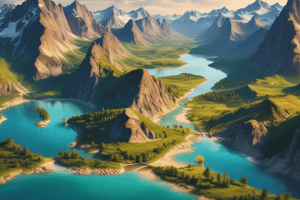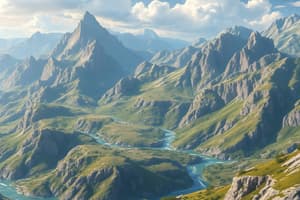Podcast
Questions and Answers
Which mountain range stretches across 8 countries in Europe?
Which mountain range stretches across 8 countries in Europe?
- The Apennine Mountains
- The Pyrenees
- The Carpathian Mountains
- The Alps (correct)
Which river is the longest in Europe?
Which river is the longest in Europe?
- The Volga River (correct)
- The Rhine River
- The Danube River
- The Seine River
What is the largest island nation in the North Atlantic?
What is the largest island nation in the North Atlantic?
- Sicily
- Ireland
- The UK
- Iceland (correct)
How many countries border the Mediterranean Sea?
How many countries border the Mediterranean Sea?
What is the 2nd largest country in Europe by population?
What is the 2nd largest country in Europe by population?
How many member states are in the European Union?
How many member states are in the European Union?
Flashcards are hidden until you start studying
Study Notes
Physical Geography
Mountains
- The Alps are the largest mountain range in Europe, stretching across 8 countries
- The Carpathian Mountains stretch across Central and Eastern Europe
- The Pyrenees separate France and Spain
- The Apennine Mountains run along the Italian peninsula
- The Balkan Mountains stretch across Eastern Europe
Rivers
- The Volga River is the longest in Europe, flowing through Russia
- The Danube River flows through 10 countries, including Germany, Austria, and Romania
- The Rhine River forms part of the border between Germany and France
- The Seine River flows through Paris, France
Islands
- Iceland is a large island nation in the North Atlantic
- The British Isles include the UK and Ireland
- The Mediterranean islands include Sicily, Sardinia, and Corsica
- The Baltic Sea is home to many small islands, including Gotland and Öland
Human Geography
Countries and Capitals
- There are 50 countries in Europe, with 6 countries bordering the Mediterranean Sea
- The European Union has 27 member states
- The 5 largest countries by population are:
- Russia (partially in Asia)
- Germany
- United Kingdom
- France
- Italy
Languages
- Indo-European languages are spoken by the majority of Europeans
- Slavic languages are spoken in Eastern Europe, including Russian, Polish, and Czech
- Romance languages are spoken in Southern Europe, including Spanish, French, and Italian
- Germanic languages are spoken in Northern and Western Europe, including English, German, and Dutch
Economic Geography
- The European Union is a major economic power, with 22 of its member states using the Euro as their official currency
- The service sector dominates the economies of Western Europe
- Agriculture is important in Eastern Europe, particularly in Poland and Romania
- The North Sea is a major source of oil and gas for Europe
Physical Geography
- The Alps are the largest mountain range in Europe, spanning across 8 countries.
- The Carpathian Mountains stretch across Central and Eastern Europe.
- The Pyrenees form a natural border between France and Spain.
- The Apennine Mountains run along the Italian peninsula.
- The Balkan Mountains stretch across Eastern Europe.
Rivers
- The Volga River is the longest in Europe, flowing through Russia.
- The Danube River flows through 10 countries, including Germany, Austria, and Romania.
- The Rhine River forms part of the border between Germany and France.
- The Seine River flows through Paris, France.
Islands
- Iceland is a large island nation in the North Atlantic.
- The British Isles include the UK and Ireland.
- The Mediterranean islands include Sicily, Sardinia, and Corsica.
- The Baltic Sea is home to many small islands, including Gotland and Öland.
Human Geography
- There are 50 countries in Europe, with 6 countries bordering the Mediterranean Sea.
- The European Union has 27 member states.
- Russia, partially in Asia, is the largest country in Europe by population.
- Germany, United Kingdom, France, and Italy are the next 4 largest countries by population.
Languages
- Indo-European languages are spoken by the majority of Europeans.
- Slavic languages are spoken in Eastern Europe, including Russian, Polish, and Czech.
- Romance languages are spoken in Southern Europe, including Spanish, French, and Italian.
- Germanic languages are spoken in Northern and Western Europe, including English, German, and Dutch.
Economic Geography
- The European Union is a major economic power, with 22 of its member states using the Euro as their official currency.
- The service sector dominates the economies of Western Europe.
- Agriculture is important in Eastern Europe, particularly in Poland and Romania.
- The North Sea is a major source of oil and gas for Europe.
Studying That Suits You
Use AI to generate personalized quizzes and flashcards to suit your learning preferences.




